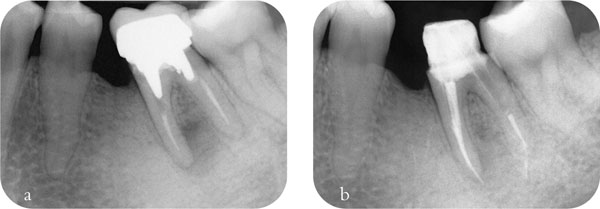Chapter 5
Problem Solving in the Restoration of Teeth with Fibre Posts
Aim
To describe how to make a customised fibre post that will adapt to a root canal of irregular shape and how to use interpenetrating polymer network (IPN) glass fibre posts.
Outcome
At the end of this chapter, the reader should understand how to make a customised fibre post-composite core restoration and to use IPN glass fibre posts.
Introduction
The vast majority of root canals have an irregular, ovoid shape in their coronal and middle thirds, elements of which may remain following preparation. The consequent lack of adaptation of the post to the root canal walls may compromise the ability of the luting agent to completely fill the post-tooth interface completely. This might be associated with decementation of the post.
If a decision is made to cement a post into a root canal, the risk of void spaces within the root canal should be minimised.
The problem of the discrepancy between the irregular cross section of the root canal and the circular cross section of the post may be difficult to solve, in particular in teeth that have undergone an endodontic retreatment including the removal of a customised cast post (Fig 5-1a,b). The preparation for the cast post and core, followed by the removal of the post often results in a wide root canal space.

Fig 5-1 (a) and (b) The lower left second molar shows a periapical radiolucency associated with an existing root canal treatment and a cast post. After removing the cast post and root canal retreatment, the tooth was re-restored with a fibre post and composite core.
Similar problems tend to be created in preparation of short roots or by the presence of severe curvatures within roots. If the length of root available for bonding is limited, the adaptation of the composite to the root canal walls must be optimised. Critical are the size and number of voids present in the layer of bonding resin and cement, which may weaken the bond between the various components of the tooth-restoration complex (dentine, bonding agent, composite, post).
Customising Fibre Posts
The adhesion of composite resin to a fibre post can be used to create a fibre post-composite core perfectly adapted to the shape of irregular root canals.
Steps required for the construction of such a fibre post customised with composite are as follows:
-
Complete the root canal treatment or retreatment (Fig 5-2a,b).
-
Remove the root canal filling material to the desired level. An endodontic probe and a heating ultrasonic tip used under magnification are useful adjuncts in this process.
-
The widest fibre post that extends the full depth of the post-space pr/>
Stay updated, free dental videos. Join our Telegram channel

VIDEdental - Online dental courses


